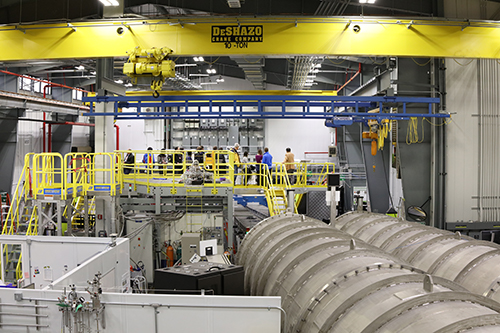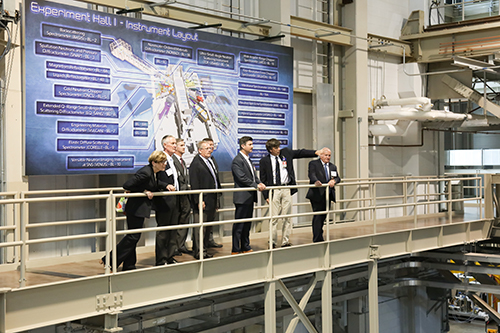Tour the Spallation Neutron Source (SNS), the High Flux Isotope Reactor (HFIR) and the TITAN Supercomputer Facilities
[Add specific tour information such as dates and times and registration info here.]
Spallation Neutron Source (SNS)
SNS is a one-of-a-kind research facility that provides the most intense pulsed neutron beams in the world for scientific research and industrial development. SNS produces neutrons with an accelerator-based system that delivers short (microsecond) proton pulses to a target/moderator system, where neutrons are produced by a process called spallation. State-of-the-art experiment stations provide a variety of capabilities for researchers across a broad range of disciplines, such as physics, chemistry, materials science, and biology.
With its more intense, brighter source of neutrons and world-class instrumentation, SNS provides the neutron scattering community with unprecedented research opportunities. SNS allows for measurements of greater sensitivity, higher speed, higher resolution, and in more complex sample environments than have been possible at existing neutron facilities.
SNS is available to researchers from all over the world with varying degrees of experience. Submitted research proposals are reviewed by independent scientists from within the neutron scattering community, and the most promising ones are chosen.

High Flux Isotope Reactor (HFIR)
Operating at 85 MW, HFIR is the highest flux reactor-based source of neutrons for research in the United States, and it provides one of the highest steady-state neutron fluxes of any research reactor in the world. The thermal and cold neutrons produced by HFIR are used to study physics, chemistry, materials science, engineering, and biology. The intense neutron flux, constant power density, and constant-length fuel cycles are used by more than 500 researchers each year for neutron scattering research into the fundamental properties of condensed matter.
The neutron scattering research facilities at HFIR contain a world-class collection of instruments used for fundamental and applied research on the structure and dynamics of matter. HFIR is also used for medical, industrial, and research isotope production; research on severe neutron damage to materials; and neutron activation analysis to examine trace elements in the environment. Additionally, the building houses a gamma irradiation facility that uses spent fuel assemblies and is capable of providing high gamma doses for studies of the effects of radiation on materials.
TITAN Supercomputer Facilities
TITAN is the first major supercomputing system to utilize a hybrid architecture, or one that utilizes both conventional 16- core AMD Opteron CPUs and NVIDIA Tesla K20 GPU Accelerators.
The combination of CPUs and GPUs will allow Titan and future systems to overcome power and space limitations inherent in previous generations of high-performance computers.
Because they handle hundreds of calculations simultaneously, GPUs can go through many more than CPUs in a given time. Yet they draw only modestly more electricity. By relying on its 299,008 CPU cores to guide simulations and allowing its Tesla K20 GPUs, which are based on NVIDIA's next-generation Kepler architecture to do the heavy lifting, Titan will be approximately ten times more powerful than its predecessor, Jaguar, while occupying the same space and drawing essentially the same level of power.




